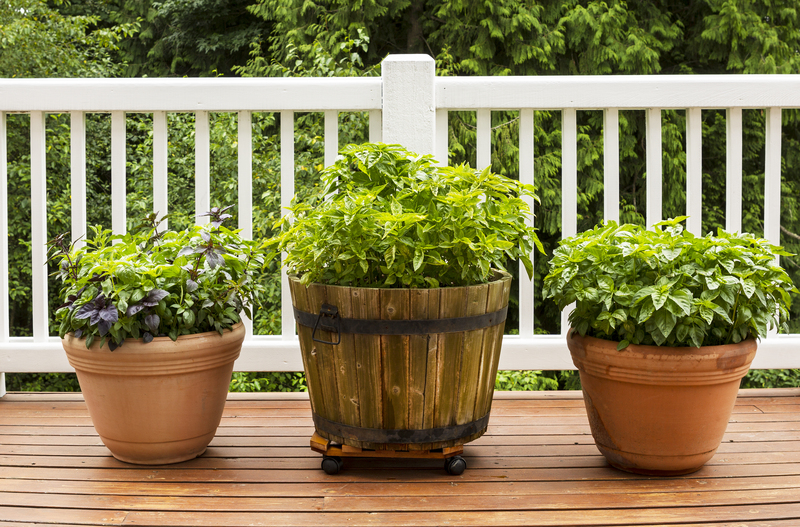Transform Your Garden into a Climate Change Solution
Posted on 22/09/2025
Transform Your Garden into a Climate Change Solution
Discover innovative, eco-friendly strategies to make your garden not only a beautiful oasis but also a powerful ally in the fight against climate change. With a thoughtful approach, anyone can transform their outdoor space into a vibrant, resilient climate change garden that makes a difference.
Why Turn Your Garden into a Climate Change Solution?
The global climate crisis is one of the most pressing challenges facing humanity today. While large-scale policy changes and technological advancements are essential, individual and community actions can play a crucial role in creating real impact. Your own garden holds immense potential to counter climate change. By transforming your backyard, allotment, or even a balcony garden into a sustainable, climate-conscious haven, you can actively reduce your carbon footprint, foster biodiversity, and inspire others.
Ready to find out how your green space can become a part of the climate change solution? This comprehensive guide will walk you through actionable steps, practical tips, and inspiring ideas for developing a climate solution garden that inside and outside the home benefits the planet.

The Climate Impact of Traditional Gardening
Traditional gardening practices, while beautiful and relaxing, often come with hidden environmental costs. Conventional gardens may rely on chemical fertilizers, fossil-fuel-powered tools, turf lawns, non-native species, and excessive water use--all of which contribute to greenhouse gas emissions and ecological imbalance.
Common Issues with Standard Gardens
- High water consumption for non-native or ornamental lawns.
- Chemical runoff from pesticides and fertilizers affecting soil and water quality.
- Gas-powered lawn equipment emitting carbon dioxide and other pollutants.
- Monoculture planting and lack of biodiversity weakening ecosystem resilience.
- Limited carbon sequestration compared to diverse, densely planted landscapes.
Transforming your gardening practices is therefore essential to mitigate these impacts and contribute positively to the climate.
1. Designing a Climate Solution Garden
The journey to turning your garden into a climate change solution starts with intentional design. Consider the existing environment, native flora and fauna, and your available resources.
Key Principles of Climate-Conscious Landscaping
- Embrace Native Plants: Native species are adapted to your local climate, require less water, and provide food and habitat for local wildlife.
- Diversify Plantings: Aim for variety to maximize climate resilience, attract pollinators, and support soil health.
- Maximize Green Cover: Replace lawns with groundcovers, wildflowers, or edible landscapes to increase carbon sequestration and reduce maintenance.
- Think in Layers: Forest-inspired "layered" gardens--combining canopy trees, understory shrubs, and ground plants--capture more carbon dioxide and create robust habitats.
- Plan for Water Efficiency: Use rain gardens, permeable pathways, and drought-tolerant plantings.
Integrative Features for a Climate-Resilient Garden
Integrate multi-functional features, such as living hedges, windbreaks, green roofs, and native plant borders, to simultaneously fight climate extremes and enhance your outdoor environment.
2. Gardening to Capture Carbon
A key principle in transforming your garden into a climate solution is boosting carbon sequestration--the process of capturing and storing carbon dioxide from the atmosphere. Plants absorb CO2 through photosynthesis, and the more green biomass and healthy soil you have, the more carbon your garden can lock away.
How to Maximize Carbon Storage in Your Garden
- Plant More Trees: Strategic tree placement cools the environment, creates shade, and absorbs incredible quantities of carbon.
- Grow Dense Shrubs and Hedges: These act as year-round carbon sponges and wind buffers.
- Encourage Soil Health: Soil teeming with organic matter is a major carbon sink. Avoid tilling, use mulches, and plant cover crops to protect and enrich earth life.
- Compost Organically: Turn garden waste and kitchen scraps into nutrient-rich compost, increasing soil carbon and reducing methane from landfill.
Every square meter of your climate change garden can help draw down atmospheric carbon if managed wisely!
3. Conserving Water and Managing Rainfall
Climate change is causing more unpredictable weather: droughts in some places, floods in others. Transforming your garden to better manage water is essential for resilience and sustainability.
Eco-Friendly Water Solutions
- Harvest Rainwater: Install rain barrels or tanks to collect runoff from roofs for later use.
- Build Rain Gardens: Designate low-lying beds to capture excess rain, filter pollutants, and recharge groundwater.
- Mulch Generously: A thick layer of organic mulch conserves soil moisture, suppresses weeds, and moderates temperature.
- Select Drought-Tolerant Species: Choose plants that thrive in your local climate with minimal watering.
- Use Drip Irrigation: Target roots directly to minimize evaporation and run-off.
Tip: Avoid using potable water for lawns and develop a routine for checking soil moisture before watering.
4. Fostering Biodiversity for Resilient Gardens
Biodiverse gardens are stronger and more adaptable to climate extremes. They also support insects, birds, and mammals while maintaining ecological balance--an often-overlooked form of climate adaptation.
Simple Ways to Boost Biodiversity in Your Garden
- Plant Pollinator-Friendly Flowers: Choose species that bloom in succession to provide a year-round food source for bees, butterflies, and other pollinators.
- Create Wildlife Habitats: Add log piles, insect hotels, ponds, birdbaths, and native shrubs to offer shelter and breeding sites.
- Avoid Chemicals: Pesticides and herbicides disrupt natural food chains and harm beneficial insects.
- Let Parts of the Garden Go Wild: Leave a corner unmown or allow leaf litter to accumulate to foster natural processes.
- Grow a Mix of Species: Avoid monoculture beds; instead, combine annuals, perennials, bulbs, and shrubs for a richly diverse ecosystem.
Regenerative Gardening Practices
Regenerative methods--like minimal tillage, perennial planting, and fostering soil life--not only boost biodiversity but also enhance carbon storage and resilience.
5. Composting: Turning Waste into Climate Action
Composting is a cornerstone of any climate change solution garden. In landfill, organic waste decays anaerobically, releasing methane, a powerful greenhouse gas. By composting at home, you return nutrients to your garden and help curb emissions.
How to Start Composting at Home
- Choose the Right Spot: Select a shaded area that's easy to access year-round.
- Balance Your Compost: Mix browns (dry leaves, straw, cardboard) with greens (kitchen scraps, grass clippings) for effective decomposition.
- Aerate Regularly: Turn the compost every couple of weeks to speed up the process and prevent odor.
- Use Finished Compost: Spread on beds or lawns to improve soil structure and fertility--reducing or eliminating the need for chemical fertilizers.
Worm bins, bokashi fermenters, and hot composting methods are all effective for different household sizes and scraps.
6. Greener Tools & Organic Inputs
Modern gardens can be resource-intensive due to fossil-fuel-powered tools and synthetic chemicals. Replace conventional inputs and methods with green alternatives.
Eco-Conscious Tool Choices
- Hand Tools Over Gas-Powered: Use rakes, push mowers, and hand shears instead of petrol-driven counterparts to cut emissions and noise.
- Solar or Battery Power: Where powered tools are necessary, opt for rechargeable or solar-powered models.
- Choose Organic Fertilizers: Use composted manure, seaweed, and green manure crops rather than synthetic chemicals.
- Natural Pest Solutions: Encourage beneficial insects, companion plant, and use physical barriers to manage problems without chemicals.
Every tool and input matters. The greener your choices, the smaller your garden's carbon footprint.
7. Grow Your Own Food: Eating for the Climate
One of the most impactful ways to create a garden that helps solve the climate crisis is by growing food. Homegrown produce is fresher and requires zero transport emissions, plus it encourages diverse, organic gardening practices.
Steps to an Edible Climate Solution Garden
- Replace Lawns with Fruit and Veg Beds: Even small plots can supply your family with greens, herbs, or berries.
- Practice Companion Planting: Mix veggies, herbs, and flowers to attract pollinators and stave off pests naturally.
- Opt for Perennials: Asparagus, berries, rhubarb, and perennial herbs need less effort and store more carbon annually.
- Use Organic Methods: Avoid chemical fertilizers and sprays on all edible plants.
- Save Seeds and Swap Locally: Reduces transport, supports resilience, and preserves genetic diversity.
Urban gardening, balcony plots, and community gardens all count! Every carrot, bean, and apple tree makes your diet more climate-friendly.
8. Removing Impermeable Surfaces for Climate Resilience
Hardscapes--like paved patios, driveways, and concrete paths--contribute to urban heat islands, prevent rainwater infiltration, and offer no ecological benefits. By reducing these surfaces, you enhance your garden's role in climate adaptation.
How to Reduce Hardscapes
- Swap Concrete for Permeable Materials: Use gravel, mulch paths, or eco-pavers that let rain soak in naturally.
- Plant Green Roofs and Living Walls: These add insulation and absorb CO2, turning fences or buildings into eco-assets.
- Create "Soft Edges": Plant around patios or driveways with dense shrubbery and groundcovers.
Aim for every square meter to either cool the air, feed the soil, or support local wildlife.

9. Inspire Others: Gardens as Climate Solutions Beyond Your Gate
Your climate solution garden can inspire a wave of eco-friendly changes in your neighborhood or city. When many people take small steps, the collective impact is tremendous.
Ways to Spread Climate-Friendly Gardening
- Host Garden Tours or Workshops: Share your experience and practical tips with friends and neighbors.
- Start a Community Garden: Work with local groups to reclaim unused land for shared fruit, veggies, and pollinator habitats.
- Advocate for Green Spaces: Encourage schools, businesses, and councils to implement climate-conscious planting schemes.
- Join Local Environmental Initiatives: Participate in native tree planting or river cleanups.
Each climate solution garden is a seed for larger change--greening cities, cooling neighborhoods, and strengthening communities.
Conclusion: Every Garden Can Be a Climate Change Solution
Climate change can often seem overwhelming, but your own outdoor space holds enormous power for positive action. By reimagining your yard, patio, or even a window box, you can help absorb carbon, manage water, boost biodiversity, and inspire sustainable living--all with beautiful, practical, nature-based solutions.
Transform your garden into a climate solution today. Experiment, learn, and share your achievements--the planet needs your patch of green!
Whether you're a seasoned gardener or just starting out, every step counts toward a healthier, more resilient future for all.



